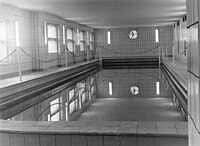Overflow channel
An overflow gutter is an artificial gutter that is installed around a container filled with liquid and catches overflowing amounts of the liquid.
Swimming pools
The overflow channel is primarily used in swimming pools . Pure water is constantly flowing into the swimming pool , bathing visitors displace water with their body volume and create wave or surge water through their movements. As a result, surface water constantly runs at the edge of the pool into the overflow channel, where it flows via the collecting piping into the raw water storage tank and then into the water treatment system . Modern overflow gutters are installed outside the pool and covered with a grid on which larger parts such as swimming goggles, foam rubber parts or leaves are collected. An all-round overflow channel is generally required in public pools. The overflow channel prevents the formation of dirt edges in the transition area between air and water.
The overflow channel starts with the overflow edge at the swimming pool. Depending on the design of the overflow edge and the shape of the channel, there are different overflow channels that differ in width, depth and design of the connection slope:
- Finnish channel
- The Finnish channel is attached as a deep shape outside the pool and behind a slightly rising overflow edge covered with water. The edge of the water is at the edge of the overflow channel or just before it.
- St. Moritz Rinne
- This channel shape is installed outside the pool and lower than the water level. Usually the basin is raised to the surroundings and the overflow channel is on the level of the normal bathroom floor. The water first runs down the pool wall and then enters the overflow channel.
- Wiesbaden channel
- The Wiesbaden channel is available in a low-lying or high-lying design. The deep Wiesbaden channel is open directly in the pool, so the water level is several centimeters below the pool edge. In the high-lying construction, the overflow channel is installed at the edge of the pool and directly adjoins the overflow edge. For these gutter shapes there are often ready-made gutter stones which, in addition to the gutter itself, also offer holding options for the swimmers. In particular, the low-lying Wiesbaden channel is no longer used in new buildings.
- Zurich Rinne
- It is attached outside the basin and behind a short straight overflow edge as a deep shape. The water edge is usually in front of the edge of the overflow channel.
Web links
- Expert knowledge overflow channels in the pool magazine
- Description of the types of overflow channels (PDF; 235 KB)
Individual evidence
- ↑ sopra seminar “Swimming pool construction” Part 3.3: Basin with overflow channel ( Memento from November 4, 2014 in the Internet Archive )




